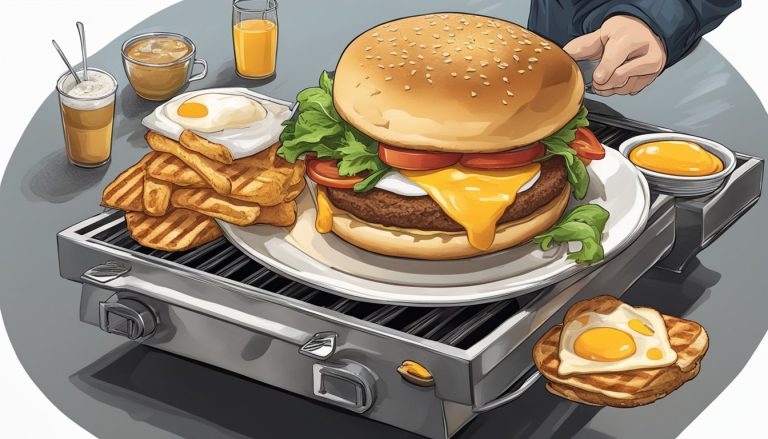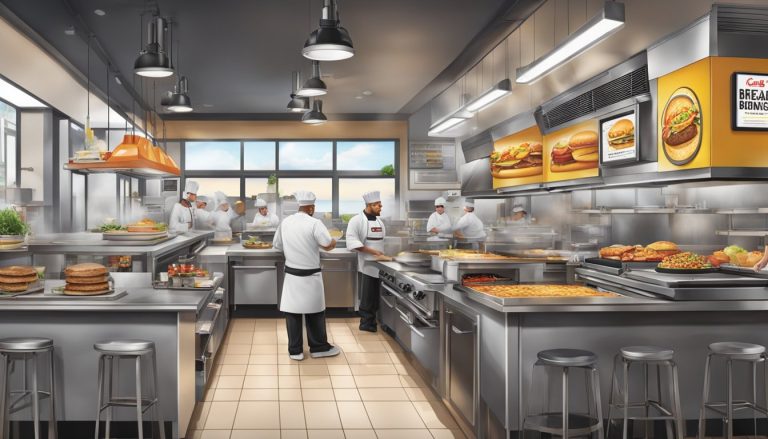Carl Karcher’s journey from a humble hot dog cart to founding one of America’s largest fast-food chains epitomizes the entrepreneurial spirit of mid-20th century America. In 1941, with just $311 in savings, Karcher and his wife Margaret opened their first hot dog stand in Los Angeles. This small venture would grow into Carl’s Jr., a fast-food empire that revolutionized quick-service dining.
Karcher’s vision of progress and innovation drove the rapid expansion of his business, transforming it from a local eatery to a national brand. His commitment to quality food and customer service set Carl’s Jr. apart in a competitive market. As the company grew, Karcher embraced new technologies and business models, including franchising, which allowed for faster expansion and increased profitability.
The story of Carl Karcher reflects broader changes in American society, including the rise of car culture, suburbanization, and changing eating habits. His success also highlights the opportunities and challenges faced by entrepreneurs in the fast-food industry, from managing rapid growth to adapting to evolving consumer preferences.
Carl Karcher’s Origins and Early Ventures

Carl Karcher’s journey from humble beginnings to fast food empire exemplifies the classic American Dream story. His path took him from rural Ohio to bustling Southern California, where he launched his first food service business and laid the foundation for a restaurant chain.
The Beginnings in Ohio and the Shift to Southern California
Carl Karcher was born on a farm near Upper Sandusky, Ohio. His parents, Leo and Anna Maria Karcher, were of Belgian and German ancestry respectively. As a young man, Carl saw opportunity in the West and made the bold decision to relocate to Anaheim, California.
In Anaheim, Carl initially worked for his uncle’s small business. This experience provided him valuable insights into entrepreneurship and the local economy. After three years, Carl left his uncle’s employ, ready to strike out on his own.
Launch of a Hot Dog Cart and the First Steps in Fast Food
In 1941, Carl Karcher took his first step into the food service industry. He borrowed $311 against his Plymouth automobile to purchase a hot dog cart in Los Angeles. This modest start proved successful, as Carl’s friendly service and quality offerings attracted a steady stream of customers.
Encouraged by his initial success, Carl soon expanded his operations. He acquired additional hot dog carts, positioning them strategically around Los Angeles. His business grew rapidly, demonstrating Carl’s keen eye for locations and customer preferences.
Expansion to Carl’s Drive-In Barbecue and Beyond
By 1945, Carl Karcher had accumulated enough capital and experience to take a significant leap forward. He and his wife Margaret opened their first full-service restaurant, Carl’s Drive-In Barbecue, in Anaheim, California. This establishment marked a turning point in Karcher’s career.
The drive-in concept proved immensely popular in car-centric Southern California. Carl’s Drive-In Barbecue offered a wider menu than his hot dog carts, including barbecue items that became customer favorites. The success of this venture set the stage for further expansion.
In the following years, Carl Karcher continued to grow his business. He opened additional locations and refined his restaurant concept. By the 1970s, his company operated over 100 restaurants, forming the basis of what would become the Carl’s Jr. fast food empire.
The Rise of Carl’s Jr. and Fast Food Innovations
Carl’s Jr. emerged as a pioneering force in the fast-food industry, revolutionizing service methods and menu offerings. The brand’s growth was marked by strategic adaptations and a keen focus on customer preferences.
Introduction of Carl’s Jr. and Distinguishing Factors
Carl’s Jr. officially launched in 1956, building on Carl Karcher’s success with his hot dog carts. The restaurant distinguished itself through its commitment to quality ingredients and innovative menu items. Carl’s Jr. introduced charbroiled hamburgers, a departure from the flat-top grilled patties common at the time.
The brand’s signature Six Dollar Burger, launched in 2001, elevated fast-food offerings by providing restaurant-quality burgers at drive-thru prices. This move positioned Carl’s Jr. as a premium fast-food option, attracting a new demographic of customers seeking higher-quality meals on the go.
Adapting to Trends: Self-Service and Expansion
Carl’s Jr. quickly embraced the self-service model, recognizing its potential for increased efficiency. The introduction of drive-thru windows in the 1970s further streamlined operations, allowing for faster service and increased customer throughput.
The chain expanded rapidly throughout the western United States, capitalizing on the growing demand for quick, convenient meals. Carl’s Jr.’s adaptability was evident in its menu evolution, introducing salad bars in the 1980s to cater to health-conscious consumers.
By the 1990s, Carl’s Jr. had established itself as a major player in the fast-food industry. The brand’s willingness to experiment with bold flavors and premium ingredients set it apart from competitors, fostering customer loyalty and driving continued growth.
The Growth of the Fast Food Industry
The fast food industry experienced rapid expansion in post-war America, driven by economic prosperity and changing consumer habits. Key figures like Carl Karcher played pivotal roles in shaping this burgeoning sector.
Post-World War II Development and Economic Factors
World War II’s end ushered in a period of economic growth and suburbanization in America. Rising incomes and increased car ownership created ideal conditions for fast food’s rise. The 1950s saw a surge in fast food establishments catering to busy families and workers seeking quick, affordable meals.
Franchising became a popular business model, allowing rapid expansion with minimal capital investment. This approach enabled chains like McDonald’s to grow exponentially across the country.
The baby boom generation contributed significantly to fast food’s popularity. Young families with disposable income embraced the convenience and novelty of drive-through restaurants.
Comparative Analysis with Other Founding Fathers
Carl Karcher’s success with Carl’s Jr. paralleled that of other fast food pioneers. Ray Kroc of McDonald’s and James McLamore of Burger King also capitalized on the growing demand for quick-service restaurants.
These entrepreneurs shared common traits:
- Innovative business practices
- Focus on standardization and efficiency
- Aggressive expansion strategies
Karcher emphasized quality and customer service, while Kroc prioritized consistency and speed. McLamore introduced the flame-broiled burger concept, differentiating Burger King in the market.
Each founder’s unique approach contributed to the industry’s diversification and overall growth.
The Expansion of Fast Food Chains in America
Fast food chains spread rapidly across the United States in the 1960s and 1970s. McDonald’s led the charge, growing from about 250 locations in 1960 to over 3,000 by 1973.
Key factors driving expansion:
- Interstate highway system development
- Increasing advertising budgets
- Streamlined operations and supply chains
Regional chains like Carl’s Jr. expanded beyond their initial markets, becoming national brands. This growth often involved acquisitions and mergers, as seen with Karcher’s purchase of Hardee’s in 1997.
By the 1980s, fast food had become deeply ingrained in American culture. The industry’s influence extended beyond food, impacting agriculture, real estate, and employment patterns across the country.
Carl Karcher’s Business Philosophy and Leadership

Carl Karcher’s approach to business centered on progress, quality, and innovation in the fast food industry. His leadership style and corporate strategies evolved as Carl Karcher Enterprises grew from a single hot dog cart into a major restaurant chain.
Karcher’s Vision of Progress and Quality
Carl N. Karcher believed strongly in progress and its positive impact on society. He viewed the growth of his business as a sign of advancement, even as it contributed to urban sprawl. Karcher prioritized food quality and cleanliness in his restaurants, setting them apart from typical fast food joints.
His commitment to progress extended to menu innovation. Karcher aimed to elevate fast food, introducing items that appealed to a broader customer base. This forward-thinking approach helped position Carl’s Jr. as a precursor to the fast casual dining segment.
Evolving Corporate Strategies within Carl Karcher Enterprises
As Carl Karcher Enterprises expanded, Karcher adapted his leadership and business strategies. He embraced the franchise model, allowing rapid growth while maintaining quality standards across locations. This approach helped transform a $326 investment into a multi-billion-dollar empire.
Karcher emphasized food safety and consistency across all restaurants. He implemented standardized processes and training programs to ensure customers received the same experience at every location. The company also focused on operational efficiency to stay competitive in the fast-paced food industry.
CKE’s corporate strategy included diversification. While Carl’s Jr. remained the flagship brand, the company acquired other restaurant chains to broaden its market presence and appeal to different customer segments.
Innovation and Cultural Impact of Fast Food
Fast food revolutionized American dining habits and shaped urban landscapes. Its influence extended beyond cuisine, transforming social norms and entertainment.
Drive-In Culture and the American Lifestyle
Drive-in restaurants capitalized on America’s love affair with automobiles. These establishments allowed customers to order and eat without leaving their cars, perfectly suiting the nation’s growing car culture.
The convenience sparked new social rituals. Teens flocked to drive-ins as hangout spots. Families enjoyed casual dinners in their vehicles. Even religious services adapted, with drive-in churches emerging to cater to on-the-go worshippers.
Fast food’s speed and affordability reshaped meal expectations. Quick, standardized meals became the norm for many Americans, altering traditional dining patterns.
Influences on Entertainment and Urban Development
Fast food chains influenced entertainment and urban planning. Disneyland, opened in 1955, incorporated fast food concepts into its design. Walt Disney saw the potential in efficient, family-friendly dining options within the park.
The proliferation of fast food restaurants changed city layouts. Drive-thrus and large parking lots became common features. Urban planners had to account for increased traffic flow around popular eateries.
Fast food’s cultural impact was explored in books like “Fast Food Nation,” which examined its effects on health, labor practices, and agricultural methods. The industry’s reach extended far beyond food, shaping American society in profound ways.
Legal and Ethical Challenges

Carl Karcher faced significant legal issues late in his career that tarnished his reputation. These challenges centered around accusations of insider trading and resulted in serious consequences for the fast food pioneer.
Insider Trading Accusations and Legal Outcomes
In 1988, the Securities and Exchange Commission charged Carl Karcher with insider trading. The SEC alleged that Karcher tipped off family members about an impending drop in Carl’s Jr. stock prices, allowing them to avoid substantial losses. Karcher denied the accusations but ultimately settled the case in 1989 without admitting guilt. He agreed to pay a $664,000 fine.
This legal battle had far-reaching effects on Karcher’s career and legacy. The Carl’s Jr. board of directors forced him to step down as chairman in 1993. Karcher’s relationship with the company he founded became strained. He faced additional challenges when he attempted to regain control of Carl’s Jr. through a proxy fight in 1994, but ultimately failed.
The insider trading case highlighted the ethical complexities faced by corporate executives. It underscored the importance of maintaining clear boundaries between personal and professional interests in the fast-paced world of public companies.
Carl Karcher’s Legacy and Impact on Fast Food
Carl Karcher’s influence on the fast food industry extends far beyond his own restaurant chain. His innovative approach and business acumen shaped modern fast food culture and operations.
Comparison with Industry Giants
Carl Karcher’s Carl’s Jr. chain stood out among competitors like Taco Bell, Kentucky Fried Chicken, and Wendy’s. While these brands focused on specific niches, Karcher aimed to elevate fast food quality overall. His emphasis on premium ingredients and larger portions set a new standard in the industry.
Carl’s Jr. differed from McDonald’s, led by Ray Kroc, in its menu diversity and target audience. Karcher’s chain appealed to a slightly older demographic with more varied tastes. This strategy helped Carl’s Jr. carve out its own market share alongside the Golden Arches.
Exploring the Karcher Legacy in Modern Context
Today, Carl Karcher’s influence is evident in the fast-casual dining trend. Many current chains have adopted his philosophy of offering higher quality food in a quick-service format. This approach bridges the gap between traditional fast food and sit-down restaurants.
Karcher’s commitment to innovation continues to inspire the industry. Modern fast food chains now experiment with premium ingredients, customizable options, and healthier alternatives – all concepts Karcher pioneered. His legacy encourages businesses to constantly evolve and improve their offerings to meet changing consumer demands.




